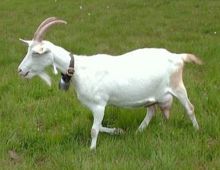Saanen goat

Saanen nanny on the Engstligenalp
|
|
| Conservation status | FAO (2007): no concern |
|---|---|
| Other names | |
| Country of origin | Switzerland |
| Distribution | worldwide |
| Standard | |
| Use | milk |
| Traits | |
| Weight |
|
| Height |
|
| Skin colour | white |
| Wool colour | white |
| Horn status | horned or |
| Notes | |
| short-haired | |
|
|
The Saanen, German: Saanenziege, French: Chèvre de Gessenay, is a Swiss breed of domestic goat. It takes its name from the Saanental in the Bernese Oberland, in the southern part of the Canton of Bern, in western Switzerland. It is a highly productive dairy goat and is distributed in more than eighty countries worldwide.
The Saanen originates in the historic region of the Saanenland (French: Comté de Gessenay) and in the neighbouring Simmental, both in the Bernese Oberland, in the southern part of the Canton of Bern, in western Switzerland. Because of its high productivity, the Saanen has since the nineteenth century been exported to many countries of the world.
The Saanen is reported from more than eighty countries. The total world population is reported to be over 900,000 head. Of these, some 14,000 are in Switzerland.
The Saanen is the largest breed of Swiss goat:billies stand about 90 cm at the withers and weigh a minimum of 85 kg. It has white skin and a short white coat; some small pigmented areas may be tolerated. It may be horned or , and tassels may be present. The profile may be straight or somewhat concave; the ears are erect and point upwards and forwards.
The Saanen is the most productive milch goat of Switzerland, which has the most productive milking goats in the world. Average milk yield is 838 kg in a lactation of 264 days. The milk should have a minimum of 3.2% fat and 2.7% protein.
...
Wikipedia
